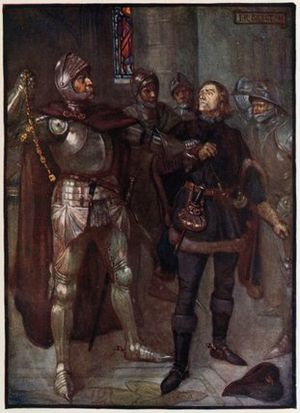Thomas (Robert) Cochrane facts for kids
Quick facts for kids
Thomas Cochrane
|
|
|---|---|

A 1906 illustration depicting Robert Cochrane (right) being arrested by the Earl of Angus in 1482
|
|
| Born | |
| Died | 1482 Scotland
|
| Cause of death | Execution |
| Other names | Robert Cochrane |
| Known for | Supposed royal servant and familiar of James III of Scotland |
Thomas Cochrane was a royal servant who lived in Scotland during the 1400s. He was a close helper and friend of King James III of Scotland. Some old stories call him "Robert Cochrane." These stories say that Cochrane had a lot of influence over the king. This made the powerful noble families, called the aristocracy, very angry. Their anger led to a sudden takeover, or coup, at a place called Lauder. During this event, King James III was arrested, and Cochrane was put to death.
It's hard to know the exact facts about Cochrane's life. Even his first name is debated. Some old records from the 1500s call him Thomas, while others say Robert. However, records from his own time (the late 1470s and early 1480s) only mention a Thomas Cochrane as an officer working for the king. Even though he doesn't appear much in official records, stories about Cochrane have greatly shaped how people view King James III's reign. These stories often say Cochrane encouraged the king to do things that weren't seen as proper for a ruler.
Contents
Stories About Cochrane's Life
Old stories from the 1500s, written by people like Robert Lindsay of Pitscottie, John Lesley, and George Buchanan, describe King James III as a weak ruler. They say he preferred to spend time with a group of talented but ordinary people, called "favourites." Cochrane was said to be the most important of these favourites.
Cochrane's Background
Pitscottie's stories claim that Cochrane started as a stone-mason. He supposedly helped the king with his building projects. A later writer, William Drummond of Hawthornden, even said Cochrane was an architect. Legend even credits him with designing the Great Hall at Stirling Castle and a hall at Falkland. However, these buildings were actually built much later.
Conflict with Nobles
The old stories also say that Cochrane advised the king to make coins worth less money. This was a way to get more cash for the king. This idea was strongly opposed by the king's younger brothers, Alexander Stewart and John Stewart. The Earl of Mar was arrested and died soon after. Alexander, Duke of Albany, escaped and found support in England.
The stories claim that the king gave Cochrane the title of Earl of Mar after his brother's death. But there are no official records from that time that show this actually happened. We do know that a Thomas Cochrane was an usher, or doorkeeper, for the king. Also, a Thomas Cochrane was made the leader of Kildrummy Castle around March 1482. This castle was in the area known as the earldom of Mar.
Arrest and Death at Lauder
The old stories tell us that Cochrane's downfall happened during an attack by an English army. This army was led by the king's brother, Alexander, Duke of Albany, and Richard, Duke of Gloucester (who later became King Richard III of England). Albany had promised to give parts of Scotland to England if they helped him become king.
The Lauder Bridge Incident
A group of Scottish nobles who supported Albany saw their chance. The Scottish army had gathered at Lauder Bridge to fight back against the English. The nobles used this opportunity to arrest King James III. They also decided to execute Cochrane and other people they believed were the king's favourites.
A story written 100 years later by Pitscottie adds more details, which might not be true. It says Cochrane arrived dressed in fancy clothes. He knocked on the church door where the angry nobles were meeting and announced, "It is I the Earle of Mar." The nobles then ripped his gold-tipped hunting horn and official chain from him. They hanged him from the bridge along with his friends, including a tailor named James Hommyll.
Much later, the noble Archibald Douglas, 5th Earl of Angus was given the nickname "Bell the Cat." This nickname came from a story that he was the one who bravely stepped forward to make sure the king's favourites were executed.
Questions About the Story
Many parts of these old stories are questioned by historians today. They compare the stories with official records that still exist from that time. Some historians believe King James III was a cultured and strong ruler, not a weak one. They defend his kingship against later criticisms.
Historians' Views
Norman Macdougall, a historian, wrote a book about James III. He argues that the king was powerful and fully in charge. Macdougall believes the stories about the king being controlled by "favourites of low birth" were made up by writers in the next century.
Macdougall found two official records of a Thomas Cochrane. One record shows Cochrane was an usher for the king. The other shows a Thomas Cochrane lost his lands near Dalkeith. Macdougall thinks this Thomas Cochrane, the usher, might be the one who died at Lauder Bridge. He also points out how the story changed over time, especially with William Drummond of Hawthornden's book. Macdougall suggests Hawthornden made Cochrane an architect to make the king look better.

